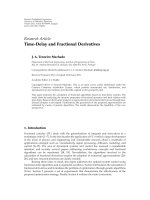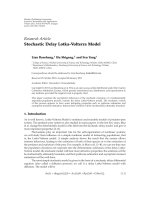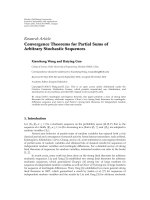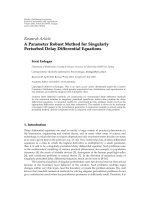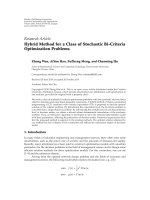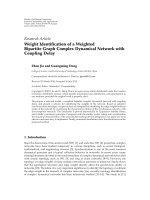Báo cáo hóa học: " Research Article Stochastic Delay Lotka-Volterra Model" docx
Bạn đang xem bản rút gọn của tài liệu. Xem và tải ngay bản đầy đủ của tài liệu tại đây (509.76 KB, 13 trang )
Hindawi Publishing Corporation
Journal of Inequalities and Applications
Volume 2011, Article ID 914270, 13 pages
doi:10.1155/2011/914270
Research Article
Stochastic Delay Lotka-Volterra Model
Lian Baosheng,
1
Hu Shigeng,
2
and Fen Yang
1
1
College of Science, Wuhan University of Science and Technology, Wuhan, Hubei 430065, China
2
Department of Mathematics, Huazhong University of Science and Technology, Wuhan,
Hubei 430074, China
Correspondence should be addressed to Lian Baosheng,
Received 15 October 2010; Accepted 20 January 2011
Academic Editor: Alexander I. Domoshnitsky
Copyright q 2011 Lian Baosheng et al. This is an open access article distributed under the Creative
Commons Attribution License, which permits unrestricted use, distribution, and reproduction in
any medium, provided the original work is properly cited.
This paper examines the asymptotic behaviour of the stochastic extension of a fundamentally
important population process, namely the delay Lotka-Volterra model. The stochastic version
of this process appears to have some intriguing properties such as pathwise estimation and
asymptotic moment estimation. Indeed, their solutions will be stochastically ultimately bounded.
1. Introduction
As is well known, Lotka-Volterra Model is nonlinear and tractable models of predator-prey
system. The predator-prey system is also studied in many papers. In the last few years, Mao
et al. change the deterministic model in this field into the stochastic delay model. and give it
more important properties 1–8.
Fluctuations play an important role for the self-organization of nonlinear systems;
we will study their influence on a simple nonlinear model of interacting populations, that
is, the Lotka-Volterra model. A simple analysis shows the result that the system allows
extreme behaviour, leading to the extinction of both of their species or to the extinction of
the predator and explosion of the prey. For example, in Mao et al. 1–8, we can see that once
the population dynamics are corporate into the deterministic subclasses of the delay Lotka-
Voterra model, the stochastic model will bear more attractive properties: the solutions will be
be stochastically ultimately bounded, and their pathwise estimation and asymptotic moment
estimation will be well done.
The most simple stochastic model is given in the form of a stochastic delay differential
equation also called a diffusion process; we call it a delay Lotka-Volterra model with
diffusion. The model will be
dx
t
diag
x
t
b Ax
t
dt By
t
dt Gdw
t
, 1.1
2 Journal of Inequalities and Applications
where ytxt−τ, xtx
1
t, ,x
d
t
T
where x
1
t, ,x
d
t
T
denotes the transpose
ofavectorormatrixx
1
t, ,x
d
t, b b
1
,b
2
, ,b
d
T
, A a
ij
∈ R
d×m
, B b
ij
∈ R
d×m
,
G γ
ij
∈ R
d×m
and wt is the m-dimensional Brownian motion, diag xt is the diag
matrix.
This model of the stochastic delay Lotka-Volterra is different from Mao et al. 3–
10, which paid more attention to the mathematical properties of the model than the real
background of the model. However, our model has the following three characteristics. First,
it is another stochastic delay subclass of the Lotka-Volterra model which is different from
Mao et al. Then we can obtain more comprehensive properties in Theorem 2.1.Second,in
this field no paper gives more attention to it so far, especially for the stocha stic delay model
which is the focus in our model. Third, this model has many real applications, for example,
in economic growth model it is different from the old delay Lotka-Volterra model which only
palys a role in predator-prey system, for example, the stochastic R&D model 9, 10 is the
best application of this model. We hope our model can have new applications of the Lotka-
Volterra model. Throughout this paper, we impose the condition
−a
ii
>A
i
j
/
i
a
ij
,
1 ≤ i ≤ d
,
1.2
where a
ij
a
ij
if a
ij
> 0.
Of course, it is important for us to point that the condition 1.2 may be not real in
predator-prey interactions, but in the stochastic R&D model in economic growth model, it
has a special meaning
−K
θ
max
i
a
ii
A
i
−
θ
θ
A
1θ
i
1 θ
1θ
|
a
ii
|
θ
i
θ
θ
A
1θ
i
1 θ
1θ
|
a
ii
|
θ
< 0. 1.3
If θ 1/2 or 1, the inequality 1.3 can be deduced to
−K
1/2
max
i
a
ii
A
i
−
2A
3/2
i
27
|
a
ii
|
i
2A
3/2
i
27
|
a
ii
|
< 0,
1.4
−K
1
max
i
a
ii
A
i
−
A
2
i
4
|
a
ii
|
i
A
2
i
4
|
a
ii
|
< 0. 1.5
If condition 1.2 is satisfied, then
lim
θ →∞
θ
θ
A
1θ
i
1 θ
1θ
|
a
ii
|
θ
0.
1.6
Therefore, if θ is big enough, condition 1.2 implies condition 1.3.
Journal of Inequalities and Applications 3
It is obvious the conditions 1.3–1.5 are dependent on the matrix A, independent
on G.
Condition 1.4 will be used in a further topic in the paper; the condition 1.4 is
complicated, we can find many matrixes A that have a property like this. For example,
A diag
a
11
,a
22
, a
dd
a
ii
< 0for1≤ i ≤ d
1.7
satisfy the condition 1.4.Furthermore,ifi
/
j, a
ij
≤ 0, or a
ij
are proper small enough positive
numbers, condition 1.4 holds too. Particularly, if d 2, the condition can be induced into
a
11
a
12
<
−2
a
21
3/2
27a
22
,a
22
a
12
<
−2
a
12
3/2
27a
11
1.8
It is clear that the upper inequalities are the key conditions in the stochastic R&D model in
economic growth model.
Let
I
θ
x
ij
a
ij
x
θ
i
x
j
.
1.9
The homogeneous function I
θ
x of degree 1 θ has the following key property.
Lemma 1.1. Suppose the matrix A satisfies condition 1.2.Let
S
x ∈ R
d
:
x
∞
1
; 1.10
then
sup
x∈S
I
θ
x
≤−K
θ
,θ>0,
1.11
where K
θ
is given in condition 1.3.
Proof. Fix x ∈ S,so0<x
j
≤x
∞
1. We will show I
θ
x ≤−K
θ
.Wehave
I
θ
x
≤
i
a
ii
x
1θ
i
i
j
/
i
a
ij
x
θ
i
x
j
≤
i
a
ii
x
1θ
i
A
i
x
θ
i
i
ϕ
i
x
i
1.12
4 Journal of Inequalities and Applications
with A
i
satisfying condition 1.2,whereϕ
i
x
i
a
ii
x
1θ
i
A
i
x
θ
i
.Since,fromcondition1.2,
ϕ
i
00, ϕ
i
1a
ii
A
i
< 0, and
ϕ
i
t
0 ⇒ t t
0
−
θA
i
1 θ
a
ii
θA
i
1 θ
|
a
ii
|
∈
0, 1
, 1.13
then
max
0≤t≤1
ϕ
i
t
ϕ
i
t
o
θ
θ
A
1θ
i
1 θ
1θ
|
a
ii
|
θ
M
i
.
1 ≤ i ≤ d
.
1.14
Since x ∈ S,wehave0<x
i
≤ 1, 1 ≤ i ≤ d, x ∈ S, and there exits at least x
i
1, such that
ϕ
i
x
i
≤ M
i
, 1 ≤ i ≤ d and at least ϕ
i
x
i
ϕ
i
1a
ii
A
i
for some i.Thus
ϕ
i
x
i
≤ max
i
⎛
⎝
a
ii
A
i
j
/
i
M
j
⎞
⎠
max
i
a
ii
A
i
− M
i
i
M
i
.
1.15
Now, from condition 1.3, the right hand of the upper equation is just −K
θ
,soI
θ
x ≤−K
θ
;
Lemma 1.1 is proved.
We use the ordinary result of the polynomial functions.
Lemma 1.2. Let f
i
1 ≤ i ≤ n be a homogeneous function of degree θ
i
, θ>θ
i
≥ 0,anda>0;then
the function as follows has an upper bound for some constant K.
F
x
n
i1
f
i
− a
d
i1
x
θ
i
≤ K
. 1.16
2. Positive and Global Solutions
Let Ω,F,{F
t
}
t≥0
,P be a complete probability space with filtration {F
t
}
t≥0
satisfying the usual
conditions, that is, it is increasing a nd right continuous while F
0
contains all P-null sets 8.
Moreover, let wt be an m-dimensional Brownian motion defined on the filtered space and
R
d
{x ∈ R
d
: x
i
> 0forall1 ≤ i ≤ d}. Finally, denote the trace norm of a matrix A
by |A|
traceA
T
Awhere A
T
denotes the transpose of a vector or ma trix A and its
operator norm by A sup{|Ax| : |x| 1}.Moreover,letτ>0 and denote by C−τ, 0; R
d
the family of continuous functions from −τ, 0 to R
d
.
The coefficients of 1.1 do not satisfy the linear growth condition, though they are
locally Lipschitz continuous, so the solution of 1.1 may explode at a finite time.
let us emphasize the important feature of this theorem. It is well known that a
deterministic equation may explode to infinity at a finite time for some system parameters
b ∈ R
d
and A ∈ R
d×m
. However, the explosion will no longer happen as long as conditions
Journal of Inequalities and Applications 5
1.2 and 1.3 hold. In other words, this result reveals the important property that conditions
1.2 and 1.3 suppress the explosion for the equation. The following theorem shows that
this solution is positive and global.
Theorem 2.1. Let us assume that K
1/2
satisfy
3K
1/2
>d
β
i
2β
i
,β
i
j
b
ij
,β
j
i
b
ij
.
2.1
Then for any given initial data {x
t
: −τ ≤ t ≤ 0}∈C−τ, 0,R
d
, there exists a unique global
solution x xt to 1.1 on t ≥−τ. Moreover, this solution remains in R
d
with probability 1,
namely, x
t
∈ R
d
for all t ≥−τ almost surely.
Proof. Since the coefficients of the equation are locally Lipschitz continuous, for any given
initial data {x
t
: −τ ≤ t ≤ 0}∈C−τ, 0,R
d
, there is a unique maximal loca l solution xt
on t ∈ 0,ρ,whereρ is the explosion time 3–10. To show this solution is global, we need to
show that ρ ∞ a.s. Let k
0
be sufficiently large for
1
k
0
< min
−τ≤t≤0
|
x
t
|
≤ max
−τ≤t≤0
|
x
t
|
≤ k
0
. 2.2
For each integer k ≥ k
0
, define the stopping time
τ
k
inf
t ∈
0,ρ
: x
i
t
/∈
k
−1
,k
, for some i 1, ,d
, 2.3
where throughout this paper we set inf φ ∞ as usual φ denotes the empty set. Clearly, τ
k
is increasing as k →∞.Setτ
∞
lim
k →∞
τ
k
, whence τ
∞
≤ ρ a.s. If we can show that τ
∞
∞
a.s., then ρ ∞ a.s. and xt ∈ R
d
a.s. for all t ≥−τ. In other words, to complete the proof all
we need to show is that τ
∞
∞ a.s. Or for all t>0, we have Pτ
k
≤ T → 0, k →∞.To
show this statement, let us d efine a C
2
-functions V : R
d
− R
by
u
t
t −ln
t
,V
t
u
√
x
i
x ∈ R
d
. 2.4
The nonnegativity of this function can be seen from
u
t
t −ln
t
> 0 on t > 0. 2.5
6 Journal of Inequalities and Applications
Let k ≥ k
0
and T>0 be arbitrary. For 0 ≤ t ≤ T ∧τ
k
, we apply the ItoformulatoV x to obtain
that
LV
x
1
2
i
√
x
i
− 1
⎡
⎣
b
i
j
a
ij
x
j
b
ij
y
j
⎤
⎦
1
8
ij
2 −
√
x
i
r
2
ij
1
2
i
b
i
√
x
i
− 1
1
8
ij
−4a
ij
x
j
r
2
ij
2 −
√
x
i
1
2
ij
b
ij
√
x
i
− 1
1
2
ij
a
ij
√
x
i
x
j
φ
x
1
2
ij
b
ij
√
x
i
x
j
−
1
2
ij
a
ij
y
j
1
2
I
x
,
2.6
where φx1/2
i
b
i
√
x
i
−11/8
ij
−4a
ij
x
j
r
2
ij
2−
√
x
i
is a homogeneous function
of a degree not above 1, G γ
ij
∈ R
d×m
,andby1.9, IxI
1/2
x,andletz x/x
∞
,for
all x ∈ R
d
;thenz
∞
1. By Lemma 1.1,weobtain
I
x
I
zx
∞
I
z
x
3/2
∞
≤−k
1/2
x
3/2
∞
≤−d
−3/2
k
1/2
|
x
|
3/2
,
2.7
whereweusethefactV
3/2
x
d
i1
x
3/2
i
and V
3/2
x ≤ dx
3/2
∞
,K
1/2
> 0, and
ij
b
ij
√
x
i
y
j
≤
ij
b
ij
⎛
⎝
x
3/2
i
3
2y
3/2
j
3
⎞
⎠
1
3
i
j
b
ij
x
3/2
i
2
3
j
i
b
ij
y
3/2
j
1
3
i
β
i
x
3/2
i
2
3
j
β
j
y
3/2
j
−
ij
b
ij
y
j
≤−
ij
b
−
ij
y
j
−
j
ρ
j
y
j
,
2.8
where b
−
ij
−b
ij
,ifb
ij
< 0, and ρ
j
i
b
−
ij
.
Thus
LV
x
≤ φ
x
1
6
i
β
i
x
3/2
i
−
1
2d
K
1/2
V
3/2
x
i
1
3
β
i
y
3/2
i
1
2
ρ
i
y
i
. 2.9
Journal of Inequalities and Applications 7
Put
W
t, x
t
V
x
t
t−τ
i
1
3
β
i
x
3/2
i
s
1
2
ρ
i
x
i
s
ds
. 2.10
Then, if t ≤ τ
k
,byLemma 1.2,weobtain
LW
t, x
t
LV
x
i
1
3
β
i
x
3/2
i
t
− y
3/2
i
t
1
2
ρ
i
x
i
t
− y
i
t
≤ φ
x
1
2
i
ρ
i
x
i
t
−
1
6d
i
3k
1/2
− d
β
i
2β
i
x
3/2
i
t
≤ K
2.11
with a constant K.
Consequently,
EW
x
τ
k
∧ T
≤ EW
τ
k
∧ T, x
τ
k
∧ T
W
0 ·x
0
E
τ
k
∧T
0
LW
t, x
t
dt
≤ W
0 ·x
0
KT.
2.12
On the other hand, if τ
k
≤ T,thenx
i
τ
k
/∈ k
−1
,k for some i; therefore,
V
x
τ
k
≥ u
1
√
k
∧ u
k
−→ ∞,
EV
x
τ
k
∧ T
≥ P
τ
k
≤ T
u
1
√
k
∧ u
k
2.13
so lim
k →∞
Pτ
k
≤ T0; Theorem 2.1 is proved.
3. Stochastically Ultimate Boundedness
Theorem 2.1 shows that under simple hypothesis conditions 1.2, 1.3,and2.1,the
solutions of 1.1 will remain in the positive cone R
d
. This nice positive property provides
us with a great opportunity to construct other types of Lyapunov functions to discuss how
the solutions vary in R
d
in more detail.
As mentioned in Section 2, the nonexplosion property in a population dynamical
system is often not good enough but the property of ultimate boundedness is more desired.
Let us now give the definition of stochastically ultimate boundedness.
8 Journal of Inequalities and Applications
Theorem 3.1. Suppose 2.1 and the following condition:
min
i
−a
ii
− A
i
> max
i
dβ
i
3.1
hold. Then for all θ>0 and any initial data {x
t
: −τ ≤ t ≤ 0}∈C−τ, 0,R
d
, there is a positive
constant K, wh ich is independent of the initial data, such that t he solution xt of 1.1 has the
property that
lim sup
t →∞
E
|
x
t
|
θ
≤ K
. 3.2
Proof. If condition 1.2 is satisfied, then
lim
θ →∞
θ
θ
A
1θ
i
1 θ
1θ
|
a
ii
|
θ
0.
3.3
By Liapunov inequality,
E
|
x
|
r
1/r
≤
E
|
x
|
θ
1/θ
, if 0 <r<θ<∞.
3.4
Sointheproof,wesupposeθ is big enough, and these hypotheses will not effect the
conclusion of the theorem.
Define the Lyapunov functions.
V
x
t
V
θ
x
t
d
i1
x
θ
i
,
x ∈ R
d
.
3.5
It is sufficient to prove
lim sup
t →∞
E
|
V
x
t
|
≤ K
0
,
3.6
with a constant K
0
, independent of initial data {x
t
: −τ ≤ t ≤ 0}∈C−τ, 0,R
d
.
We have
LV
θ
x, y
i
θx
θ
i
⎡
⎣
b
i
j
a
ij
x
j
b
ij
y
j
⎤
⎦
θ
θ − 1
2
ij
γ
2
ij
x
θ
i
i
θx
θ
i
⎛
⎝
b
i
θ − 1
2
j
γ
2
ij
⎞
⎠
θI
θ
x
θ
ij
b
ij
x
θ
i
y
j
≤ cV
θ
x
θI
θ
x
θ
ij
b
ij
x
θ
i
y
j
,
3.7
Journal of Inequalities and Applications 9
where c max
i
θb
i
θ−1/2
j
γ
2
ij
is constant and I
θ
x is given in 1.9.Letz x/x
∞
,
for all x ∈ R
d
;byLemma 1.1,wehave
I
θ
x
I
θ
z
x
∞
I
θ
z
x
1θ
∞
≤−K
θ
d
−1−θ
|
x
|
1θ
.
3.8
Then,
I
θ
x
≤−K
θ
x
1θ
∞
≤−K
θ
d
−1
V
θ1
x
,
ij
b
ij
x
θ
i
y
j
≤
ij
b
ij
1
1 θ
θx
1θ
i
y
1θ
j
.
3.9
Thus we obtain
LV
θ
x, y
≤ cV
θ
x
−
θ
d
1 θ
i
1 θ
K
θ
x
1θ
i
− dβ
i
θx
1θ
i
− dβ
i
y
1θ
i
, 3.10
and from 1.3
lim
θ →∞
K
θ
min
i
−a
ii
− A
i
,
3.11
if θ is big enough, then
1 θ
K
θ
>d
θβ
i
e
τ
β
i
. 3.12
By Lemma 1.2 and inequality 3.12,
e
s
EV
θ
x
s
|
t
0
E
t
0
e
s
V
θ
x
s
LV
θ
x
s
ds
≤
t
0
e
s
c
1
V
θ
x
s
−
θ
d
1 θ
i
1 θ
K
θ
− dβ
i
θ
x
1θ
i
s
ds
E
t
0
e
s
i
β
i
θ
1 θ
x
1θ
i
s − τ
ds
c
1
c 1
≤ E
t
0
e
s
c
1
V
θ
x
s
−
θ
d
1 θ
i
1 θ
K
θ
− dβ
i
θ − de
τ
β
i
x
1θ
i
s
ds
Ee
τ
0
−τ
e
s
i
β
i
θ
1 θ
x
1θ
i
s
ds
10 Journal of Inequalities and Applications
≤ E
t
0
e
s
c
1
V
θ
x
s
− c
2
V
1θ
x
s
ds Ee
τ
0
−τ
e
s
i
β
i
θ
1 θ
x
1θ
i
s
ds
≤
t
0
K
0
e
s
ds Ee
τ
0
−τ
e
s
i
β
i
θ
1 θ
x
1θ
i
s
ds
≤ K
0
e
t
− K
0
Ee
τ
0
−τ
e
s
i
β
i
θ
1 θ
x
1θ
i
s
ds,
3.13
where c
2
inf
i
θ/d1 θ1 θK
θ
−dβ
i
θ −de
τ
β
i
> 0 is a constant. Then 3.2 follows from
the above inequality and Theorem 3.1 is proved.
4. Asymptotic Pathwise Estimation
In the previous sections, we have discussed how the solutions vary in R
d
in probability or in
moment. In this section, we will discuss the solutions pathwisely.
Theorem 4.1. Suppose 2.1 holds and the following condition:
K
1
>d
3/2
e
τ
B
4.1
is satisfied, where K
1
is given by 1.5 and B sup
x1
|Bx|. Then for any initial data {x
t
: −τ ≤
t ≤ 0}∈C−τ, 0,R
d
,thesolutionxt of 1.1 has the property that
lim sup
t →∞
1
t
ln
|
x
t
|
K
1
d
−3/2
−
B
t
0
|
x
s
|
ds
≤
|
b
|
−
λ
2d
a.s., 4.2
where λ λ
min
GG
T
.
Proof. Define the Lyapunov functions
V
x
V
1
x
, for x ∈ R
d
.
4.3
By Ito’s formula, we have
LV
x, y
V
x
b
T
x I
1
x
x
T
By
V
x
≤
|
b
||
x
|
− K
1
d
−1
|
x
|
2
|
x
|
B
y
V
x
≤
|
b
|
− K
1
d
−3/2
|
x
|
B
y
.
4.4
Journal of Inequalities and Applications 11
Therefore,
ln V
x
|
t
0
t
0
LV
s
V
s
−
Z
s
2
2
ds M
t
≤
t
0
|
b
|
− K
1
d
−3/2
|
x
s
|
B
y
s
−
Z
s
2
2
ds M
t
,
4.5
where
M
t
t
0
Z
s
dw
s
,
4.6
where Z x
T
G/V x is a real-valued continuous local martingale vanishing at t 0andits
quadratic form is given by
M
t
,M
t
t
0
Z
s
2
ds,
4.7
and then
|
Z
|
2
V
−2
x
x
T
GG
T
x ≥
λ
d
. 4.8
Now, let δ ∈ 0, 1 be arbitrary. By the exponential martingale inequality 3–10,wecanshow
that for every integer n ≥ 1,
P
sup
0≤t≤n
M
t
−
δ
2
t
0
|
Z
|
2
ds
≥
2lnn
δ
<
1
n
2
. 4.9
Since the series
∞
n1
1/n
2
converges, the well-known Borel-Cantelli lemma yields that there
is Ω
0
⊂ Ω with P Ω
0
1 such that for every ω ∈ Ω
0
there exists a random integer n
0
ω such
that for all n ≥ n
0
ω,
sup
0≤t≤n
M
t
−
δ
2
t
0
|
Z
|
2
ds
≤
2lnn
δ
4.10
which implies
M
t
≤
δ
2
t
0
|
Z
s
|
2
ds
2
δ
ln
t 1
on 0 ≤ t ≤ n a.s.
4.11
12 Journal of Inequalities and Applications
Substituting this into 4.6 and making use of the upper inequality, we derive that
ln V
x
t
− ln V
x
0
−
2
δ
ln
t 1
≤
t
0
|
b
|
−
K
1
d
3/2
|
x
s
|
B
y
s
−
λ
1 −δ
2d
ds
≤ t
|
b
|
−
λ
1 −δ
2d
−
K
1
d
3/2
−
B
t
0
|
x
s
|
ds
0
−τ
B
|
x
s
|
ds.
4.12
Therefore,
lim sup
t →∞
1
t
ln
|
x
t
|
K
1
d
−3/2
−
B
t
0
|
x
s
|
ds
≤
|
b
|
−
λ
1 −δ
2d
, a.s. 4.13
Puting δ → 0, we can get inequality4.2.
5. Further Topic
In this section, we introduce an economic model named stochastic R&D model in economic
growth 10; for the notion of the model, see details in reference 9, 10.Theequationis
d
x
y
x
y
p
q
−θξ
α −β
x
y
dt
aθ bη
aα bα
dW
1
dW
2
, 5.1
whereweputthedelayτ 0; it is clear that the property of the model can be done b y the
example of condition 1.4. So we have the following theorem.
Theorem 5.1. Let the following conditions be satisfied
ξ − θ<
−2α
3/2
27β
,α− β<
−2ξ
3/2
√
27θ
.
5.2
Then for any given initial data x
0
,y
0
∈ R
d
, there exists a unique global solution to 5.1 on t ≥ 0.
Moreover, this solution remains in R
d
with probability 1.
Remark 5.2. The explanations in population dynamic of the conditions 1.2, 1.3,and2.1
for 1.1 are worth pointing out. Each species x
i
has a special ability to inhibit the fast growth;
the relationship of the species is the role of either species competition a
ij
< 0,i
/
j,oralow
level of cooperation a
ij
> 0,i
/
j, but they are small enough.
Acknowledgment
This paper is supported by the National Natural Science Foundation of China 10901126,
research direction: Theory and Applications of Stochastic Differential Equations.
Journal of Inequalities and Applications 13
References
1 G. Marion, X. Mao, and E. Renshaw, “Convergence of the Euler scheme for a class of stochastic
differential equation,” International Mathematical Journal, vol. 1, no. 1, pp. 9–22, 2002.
2 B. Lian and S. Hu, “Stochastic delay Gilpin-Ayala competition models,” Stochastics and Dynamics,vol.
6, no. 4, pp. 561–576, 2006.
3 B. Lian and S. Hu, “Asymptotic behaviour of the stochastic G ilpin-Ayala competition models,” Journal
of Mathematical Analysis and Applications, vol. 339, no. 1, pp. 419–428, 2008.
4 X. Mao, G. Marion, a nd E. Renshaw, “Environmental Brownian noise suppresses explosions in
population dynamics,” Stochastic Processes and Their Applications, vol. 97, no. 1, pp. 95–110, 2002.
5 Z. Teng and Y. Yu, “Some new results of nonautonomous Lotka-Volterra competitive systems with
delays,” Journal of Mathematical Analysis and Applications, vol. 241, no. 2, pp. 254–275, 2000.
6 X. Mao, S. Sabanis, and E. Renshaw, “Asymptotic behaviour of the stochastic Lotka-Volterra model,”
Journal of Mathematical Analysis and Applications, vol. 287, no. 1, pp. 141–156, 2003.
7 A. Bahar and X. Mao, “Stochastic delay Lotka-Volterra model,” Journal of Mathematical A nalysis and
Applications, vol. 292, no. 2, pp. 364–380, 2004.
8 X. Mao, C. Yuan, and J. Zou, “Stochastic differential delay equations of population dynamics,” Journal
of Mathematical Analysis and Applications, vol. 304, no. 1, pp. 296–320, 2005.
9 P. Howitt, “Steady endogenous growth with population and R&D inputs growth,” Journal of Political
Economy, vol. 107, pp. 715–730, 1999.
10 B. Lian and S. Hu, “Analysis of the steady state of a mixed model,” Journal of Mathematics, vol. 27, no.
3, pp. 307–311, 2007 Chinese.
